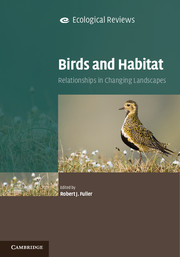Book contents
- Frontmatter
- Contents
- List of Contributors
- Preface
- Part I The complexity of patterns and processes
- Chapter One The bird and its habitat: an overview of concepts
- Chapter Two Habitat quality and habitat occupancy by birds in variable environments
- Chapter Three Spatial variation and temporal shifts in habitat use by birds at the European scale
- Chapter Four Mechanisms and processes underlying landscape structure effects on bird populations
- Chapter Five Avian responses to transitional habitats in temperate cultural landscapes: woodland edges and young-growth
- Chapter Six Habitat associations of birds in complex changing cultural landscapes
- Chapter Seven The importance of habitat heterogeneity at multiple scales for birds in European agricultural landscapes
- Part II Case studies of habitat use and selection
- Part III Wider perspectives
- Species index
- Subject index
- References
Chapter Seven - The importance of habitat heterogeneity at multiple scales for birds in European agricultural landscapes
Published online by Cambridge University Press: 05 December 2012
- Frontmatter
- Contents
- List of Contributors
- Preface
- Part I The complexity of patterns and processes
- Chapter One The bird and its habitat: an overview of concepts
- Chapter Two Habitat quality and habitat occupancy by birds in variable environments
- Chapter Three Spatial variation and temporal shifts in habitat use by birds at the European scale
- Chapter Four Mechanisms and processes underlying landscape structure effects on bird populations
- Chapter Five Avian responses to transitional habitats in temperate cultural landscapes: woodland edges and young-growth
- Chapter Six Habitat associations of birds in complex changing cultural landscapes
- Chapter Seven The importance of habitat heterogeneity at multiple scales for birds in European agricultural landscapes
- Part II Case studies of habitat use and selection
- Part III Wider perspectives
- Species index
- Subject index
- References
Summary
Farmland throughout the world is frequently likened to a mosaic or patchwork and this heterogeneity is widely recognised as strongly influencing the abundance and diversity of species that these landscapes support. Globally, modern intensive agriculture has greatly reduced this ‘patchiness’ at a range of spatial and temporal scales. This change has been particularly well documented in temperate Europe (Benton et al., 2003; Báldi et al., 2005; Roschewitz et al., 2005; Wretenberg et al., 2006; Stoate et al., 2009). The fine-grained, diverse habitat mosaic, typical of much ‘traditional agriculture’, has become increasingly uniform under modern agricultural management. This reduction in habitat complexity has been linked, at least in part, to declines in farmland biodiversity, including plants and invertebrates (Smart et al., 2000; Sotherton and Self, 2000; Oliver et al., 2010), mammals (Smith et al., 2005) and birds (Donald et al., 2001a; Benton et al., 2003; Wilson et al., 2005).
In general, the more habitat elements a farmed landscape contains, the wider the range of resources on offer and the higher the diversity and abundance of organisms supported. This may be due, in part, simply to the increased likelihood of a given farmed landscape containing a key habitat type (Heikkinen et al., 2004). However, many species require a diversity of resources to complete their life cycle. At its most basic, birds require two essential resources: a suitable nest site and sufficient food throughout the year. These basic nesting and foraging requirements often vary within and between seasons. Bird-rich farmland should provide safe foraging habitats, offering abundant and accessible food in relatively close proximity to suitable cover for nesting and/or protection from predators or harsh weather. The extent to which farmland birds require a diverse landscape matrix, containing both density, number of chicks per nest and annual productivity compared to semi-natural and cultivated habitat components, is illustrated by many examples in the following sections.
- Type
- Chapter
- Information
- Birds and HabitatRelationships in Changing Landscapes, pp. 177 - 204Publisher: Cambridge University PressPrint publication year: 2012
References
- 47
- Cited by

